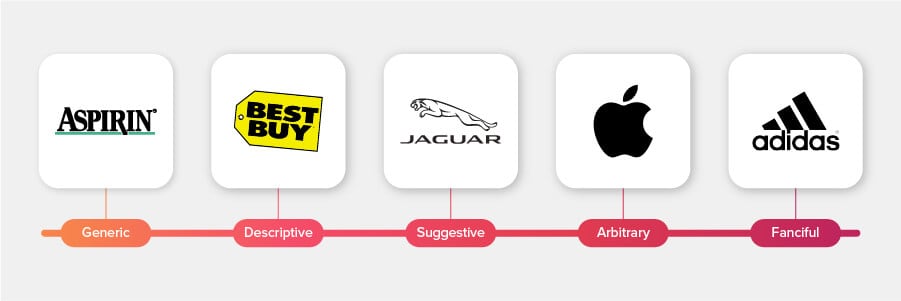1. Not performing an availability search before applying
When applying for a trademark, the most common mistake is not performing an availability search.
An availability search is when you research websites like USPTO, Google, or the global brand database search tool, WIPO, to confirm whether your trademark design is available.
USPTO will decline your application if a trademark is already used or deemed too similar. And if you manage to file a similar design and another company believes it infringes on their intellectual rights (any mark registered as a trademark), they could sue you.
The good news is trademark law operates on a first-come, first-served basis, so if a mark like yours exists, you can find out before applying.
Start by looking at the Trademark Electronic Search System (TESS) for similar or exact trademarks as your design you’ve already applied for or registered. And for global businesses, Google should confirm the availability of your new mark.
2. Choosing the wrong trademark classes
Choosing the right trademark class is the most challenging part of the trademark application process and where most people make mistakes.
The USPTO (and every other country’s equivalent) uses numbered classes to identify different products and services. This allows users to register trademarks by filing them with their matching number.
For example, the U.S. filing system has 45 categories, 34 for products and 11 for services. Sounds easy, right?
The problem is each class has dozens of different products or services under one number. And you must choose the exact one that describes the product or service you need to apply your trademark under.
There’s a lot to learn about choosing the right trademark class, and you’ve got to get it right because entering your mark in the wrong class could result in a loss of your trademark protection. Your only option would then be to apply (and pay) again.
3. Not having a distinctive trademark
The most memorable trademarks are “distinctive trademarks,” They’re also the easiest type of mark to register with the USPTO and defend in cases of infringement.
Any attempt to register a mark that’s generic usually ends in a rejection. Generic terms describe a general class of services or products, not a specific business brand.
For instance, a coffee shop applying to register a mark like “Pure Ground Coffee” would probably fail as those words are generic to that industry. Similarly, a hotel chain wanting to use “Best U.S. Hotels” would find it difficult to get approval.
Also, don’t use words that describe a product’s function, characteristics, quality, or ingredients, like “cold and creamy” for an ice cream brand or “fresh” for coffee, as all are generic terms.
But there’s another problem with using a generic term, even with trademark approval! Sometimes, when a brand becomes famous and the name becomes synonymous with the product or service, it can lose trademark protection. Examples are Thermos, escalator, Aspirin, and Hoover for UK readers.
So, what’s a distinctive trademark? There are 3 categories to choose from:
- Arbitrary: An arbitrary mark is a word or term with a known meaning but unrelated to the product or service they represent, such as Amazon (e-commerce), Apple (technology company), and Shell (petroleum).
- Fanciful: Fanciful marks are made-up, born from our imagination, with little meaning in most languages. They only exist as trademarks for a specific brand’s product or service. Like Clorox (detergents and bleach), Kodak (photography), and Fiverr (freelance employment).
- Suggestive: Suggestive marks hint at a product or service’s attribute or nature without describing its functional purpose. Some examples are Jaguar (fast, luxurious cars), Netflix (online tv/movies), and Airbus (aviation).
-
Be distinctive and choose an arbitrary, fanciful, or suggestive term to make your trademark distinct and unique to your brand, thus separating you from competitors and ensuring the public remembers you.
4. Using the TM symbol incorrectly
Once you file your trademark application and receive trademark grant approval from the U.S. Patent and Trademark Office, you can use the ® symbol.
However, you must adhere to rules when you use the ® symbol. Fortunately, they come with a level of flexibility. For example, depending on preference, you can either position the ® symbol level with your trademark (logo or slogan) in the top right-hand corner or the bottom right-hand corner.
And when using specific advertising strategies, you can avoid using the ® symbol altogether to prevent clutter.
Be aware that using the ® symbol incorrectly may cause the examiner to deny your trademark registration or another business to oppose your mark’s registration. Additionally, improper use in the marketplace could result in false advertising or fraud charges.
5. Not enforcing trademark protection
USPTO’s job is to approve and register trademarks, but it’s your responsibility to enforce trademark protection and stop infringements.
Enforcing trademark protection is how you discover if someone else is using your mark, and if they are, identifying them, notifying them to stop, and implementing an appropriate response if they persist with their infringement.
If that sounds like an impossible task, you can employ a trademark monitoring service or an attorney who’ll notify you of trademark infringements. They’ll advise you on the best action to take should another business use your mark.
In most cases, a cease-and-desist notification (a “stop using my trademark or I’ll sue you” letter) sent by a lawyer is enough to deter any unauthorized use of your mark. But sometimes, you’ll need to take further action.
In my personal experience, I was selling products online and a foreign seller began using my trademark on a similar but inferior product. The risk was I’d lose my brand’s reputation and potential customers. After several email requests to stop and a formal letter from an attorney, it took notification of court proceedings to deter the seller.


